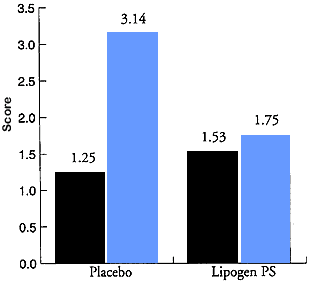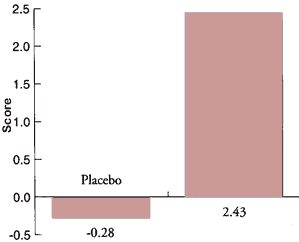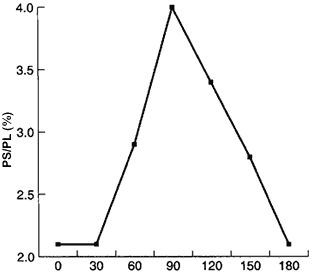|
Stephen A. Levine, Ph.D.
I became interested in Phosphatidylserine
after hearing Parris Kidd, Ph.D. lecture in 1996. As I reviewed the literature,
the applications were impressive, with broad anti-aging effects, memory
boosting, and mood enhancement in normal individuals. There are specific
benefits for patients with Minimal Memory Disorder (MMDI), Alzheimer's,
Parkinson's disease, and depression. The dosage used in almost all double-blind
studies is 300 mg per day of Phosphatidylserine taken over a two or three month
period. In some cases, even higher dosages are utilized with apparent further
benefit and over longer periods of time. To my knowledge, no serious side
effects have been reported.
I have reviewed almost 20
double-blind clinical trials, and other human studies. Most of the important
studies were done in the late 1980's treating Alzheimer’s disease,
cognitive decline in aging, dementia, mental impairment and mood in aged
patients, in depressive disorders, in inhibition of the stress response, and in
patients with arteriosclerotic disease. I will review salient points to
highlight the potential broad ranging benefits from Phosphatidylserine
administration.
Until recently, the vast majority of
studies utilized Bovine Cortex-derived Phosphatidylserine (BC-PS) (Fidia
pharmaceutical grade). Presently, the use of bovine brain material has come
into disfavor. The use of plant Phosphatidylserine from soy (SPS) does not pose
a risk to patients in developing prion infection. So far, four studies that we
know of have been performed with S-PS. The study supports previous research
with BC-PS, also confirming that PS is the active agent in the previous studies
and not some unknown "carry along" compound. This study, by Gindin et al.,
stands out because two additional parameters of clinical interest were noted.
The patients were asked if they would continue to use PS even if they had to
pay for it, and their positive response strongly supported the efficacy of the
compound, as will be discussed. Secondly it was observed that PS prevented
depressive symptoms associated with winter depression (see figure 1) This was a
statistically significant finding and it expands the spectrum of benefits now
associated with PS to include Seasonal Affective Disorder.
Depression Symptoms Score
Placebo
(N=26) P< (N=31) P<0.4 |

| Figure
1 |
Gindin J. et al.,
1995 |
Many age-related neurochemical changes can
be traced to structural and functional changes in neuronal membranes, which
have been related to changes in lipid composition or content of the aging
brain. This lead to the administration of phospholipids (Interdiscipl Topics
Gerontol 15: 34-53, 1979; ACTA Psychiatr Scand 81: 265270, 1990; Neurobiol
Aging 5: 323-333, 1984). BC-PS was found to enhance the activities of
membrane-bound enzymes in neurotransmitter release and signal transduction,
stimulate catecholaminergic neurotransmission and acetylcholine release and
synthesis in the cerebral cortex. (Life Sci. 23: 1093- 1102. L987, Clin Trials
J. 24 9-17 1987; Neurobiol Aging 8: 403-407)
In a 1988 article, (Amaducci L, and the
SMID Group), it was found that among the severely impaired patients, or those
on the placebo over a six-month period, all parameters declined, while those
treated for the first three months with PS improved during the second period.
Some of the effects were mild in early treatment, however, six months after the
beginning of treatment, the effects were detected on a wider range of measures
and were more clearly apparent. These findings suggest that PS may prevent
further cognitive decline in Alzheimer's dementia (AD) patients, and the
effects may persist beyond the period of administration.
In a study done in 1986, (Delwaide PJ, et
al.), a double-blind format was used to study the effects of PS in senile
demented (SD) patients. The results at the end of the study were the same as
those obtained three weeks later. The types of behaviors that were most
modified included dressing, feeding, bowel and bladder control, ability to go
to the toilet unaided, interpersonal relations, relationship to the
environment, behavioral problems, and verbal expression. In the treatment
group, a positive difference was seen for all 10 categories whereas in the
placebo group, deterioration was seen in four categories. This data may
indicate the kind of overall benefit in quality of life, which may be achieved.
A double-blind placebo-controlled trial
was conducted with BC-PS in elderly patients with chronic cerebrovascular
disease (Villardita C., et al., 1987). At the standard dosage of 300 mg, the
compound was not significantly better than the control in psychometric
parameters, as demonstrated by EEG and in clinical status. However flicker
fusion frequency improved both after rest and after mental activity. The lack
of cognitive effects stands out in this study. However, only a few cognitive
functions were assessed and were normal initially, whereas the flicker function
test was below the normal range, and was normalized by the treatment.
Senile mental deterioration was studied in
three clinics in Italy, using BC-PS over a 60-day period in double-blind
placebo format (Palmieri, G., et al., 1987). They concluded that BC-PS appears
to exert relevance of the effects in two contexts; one relating to cognitive
functions of vigilance, attention, and short-term memory, and the other
relating to behavioral aspects such as apathy, withdrawal and daily living.
According to the article, "the observed effects may not only improve the
quality of life of these patients, but may also contribute to keeping them
within their own families and social background".
In 1989, (Liss, Alan R., 1987), a
double-blind study was reported. The test group was less depressed and less
anxious than the placebo group. In this case a subgroup of patients with more
severe motor disturbances responded more significantly. IV injection of BC-PS
produced obvious clinical response within six hours after injection.
A double-blind study in 1992 evaluating
early Alzheimer's dementia was published in Europe (Engel, RR. et al.). Using
BC-PS on 33 patients, a small but significant improvement, according to
clinicians global judgment occurred. EEG mapping indicated global normalization
and simple reaction time improvement. The GBS dementia rating scale (and
pyschometric test scores) did not change significantly The clinicians’
global rating score indicates an improvement in patients overall functioning.
In a 1993 study, 494 patients from 23
geriatric or general medicine units in Italy were studied (Cenacchi, B., et
al.) using BC-PS. The results indicated that the BC-PS group compared to the
placebo group showed significantly improved behavior, such as increased
motivation, initiative, interest in the environment, and socialization, which
were present to various extents in patients upon admission. The study noted
that “the resulting improvements in adaptability to the environment can
have an important impact on the quality of life of such patients.” The
administration of BC-PS together with other drugs failed to show any
pharmacological interactions, as judged by the lack of clinical signs and
symptoms. This was a large multi-center study that provides impressive stature
to the research.
In a 1991 study, (Crook, TH. et al.),
using the standard three month, 300 mg dosage of BC-PS, significant differences
were noted in 6 out of 20 parameters. All significant differences favored
BC-PS. Each of the differences favoring the BC-PS were during the final
treatment period (Week 12), and were lost beyond one month after termination of
treatment (Week 16). These observations strengthen the experimental conclusion
of benefit by BC-PS. Benefits were found in a number of outcomes, such as
important tasks of daily life, plus learning and recalling names, faces, and
numbers. "Persons most likely to benefit were those above the range of
cognitive performance associated with dementia disorders such as Alzheimer's
disease, but performed in the low range of normality," is quoted from the
study.
"Hence, the compound may be valuable as a
prophylactic treatment for Alzheimer's and related dementia-inducing
disorders". Some additional benefits on psychometric testing (neuromotor
skills) were not significant until after the end of the 12-week period,
although clinical benefits were observed after the first three weeks of
treatment.
The cognitive effect and behavioral
symptoms of BC-PS were studied in 10 elderly women with depressive disorders in
which BC PS was administered. Increased brain turnover of noradrenaline,
dopamine, acetylcholine and cAME, as well as induced accumulation of glucose
were noted. The depressive symptoms in the patients were marked before
treatment and after placebo, and were significantly reduced by BC-PS therapy.
The HRSD (Hamilton Rating Scale for Depression), as it relates to anxiety,
revealed elevated basal scores that did not change after placebo and improved
significantly after treatment. The remission in symptoms was clear-cut, based
both on clinical observations by medical and paramedical staff, as well as by
the analysis of HRSD scores. In particular, drive interests and socialization
were increased as described, "the improvement in long-term memory was
particularly significant in our patients", and it appeared that learning was
also improved.
Phosphatidylserine also appears to protect
against the stress response and to reduce anxiety, as demonstrated in previous
studies. In a 1990 study (Monteleone, P., et al.), the response of BC-PS to
physical stress was tested in eight healthy men who underwent three experiments
with a bicycle ergometer in a double-blind format. The physical stress from
exercise induced a clear cut increase in plasma epinephrine, norepinephrine,
ACTH, cortisol, growth hormone, and prolactin, whereas pretreatment with 50-75
mg of BC-PS significantly blunted the (ACTH and cortisol response to the
exercise. Plasma growth hormone and prolactin responses to physical stress were
not affected by BC-PS.
In 1995, a 2-month treatment study
(Gindin, J. et al.) using plant-derived phosphatidylserine (S-PS) showed
positive effects on daily functioning, emotional state and self-reported
general condition of Alzheimer's disease patients. (See figure 2) In a
post-trial consumption survey, nearly half of the participants of the treatment
group decided to continue treatment at their own expense, in contrast to none
in the placebo group. These results of a short-term treatment which had no
negative side effects encourages the use of S-PS with AD patients in order to
evaluate on an individual basis possible improvement in patient condition.
These results also encourage further investigation into long-term treatment and
on larger groups with regard to the patient's AD status, i.e. early, mild and
severe AD.
Memory
Test Score
Wechsler >68, P<0.03 |

| Figure
2 |
Gindin J. et al.,
1995 |
In September of 1999, a report summarized
results of a study on the kinetics of soy lecithin phosphatidylserine (S-PS)
absorption by the body. (See figure 3 chart on bottom right.) The study was
carried out in July 1996 with standard soft gelatin capsules containing S-PS
supplied by Lipogen Ltd. in Israel. From the study the following was concluded:
- The capsules disintegrated after 30 minutes.
- The PS was well tolerated by the body.
- The basal serum level was reached after 180 minutes
from intake.
- No side effects were reported.
| The overall average profile of the PS/PL values
attained in the test are shown in the chart below. No Adver effects or any
discomfort was reported by the participants |
PS Levels
in Blood Serum

Time (min)
| Figure
3 |
Shinitsky, M, Ph.D.,
1196 |
Soy lecithin phosphatidylserine complex
(S-PS) is considered a dietary supplement (lecithin and other phospholipids)
and is freely sold as a supplement product (Israel, Europe, USA, etc.).
References
Amaducci L, and the SMlD Group.
Phosphatidylserine in the treatment of Alzheimer's disease: results of a
multicenter study. Psychopharmocol Bull. 24:130-134, 1988.
Cenacchi, B., et al., Cognitive decline in
thc elderly: a double-blind placebo-controlled multi-center study on efficacy
of phosphatidylserine administration. Clin Exp. Rcs. 5:123-133, 1993.
Crook, TH. et al., Effects of
phosphatidylserine in age-associated memory impairment Neurol. 41:644-649,
1991.
Crook, TH, et al., Effects of
phosphatidylserine in Alzheimer’s disease, Psychopharmacol. Bull.,
28:61-66, 1992.
Delwaide PJ, et al. Double-blind
randomized controlled study of phosphatidylserine in demented patients. Acta
Ncurol Scand, 73: 136-140, 1986.
Engel, RR. et al. Double-blind cross-over
study of phosphatidylserine vs. placebo in subjects with early cognitive
deterioration of the Alzheimer type. Eur Ncuropsychopharmacol. 2: 149-155,
1992.
Funfgeld, EW, et al., Double-blind study
with phosphatidylserine (PS) in Parkinsonian patients with senile dementia of
Alzheimer's type (SDAT), Progr. Clin. Biol. Rcs. 317:1235-1246, 1989.
Gindin, J., et al. 1990, Effect of Soy
Lecithin Phosphatidylserine (PS) Treatment on Daily Functioning and
Self-Reportcd General Condition in Patients with Alzheimer's Disease, The
Geriatric Institute of Education and Research Kaplan Medical Centre, Rehovot,
and Hadassah Medical School, Hebrew University of Jerusalem, Israel.
Interdiscipl. topics Gerontol 15: 34-53,
1979; ACTA Psychiatr Scand 81: 265-270, 1990; Neurobiol Aging 5: 323-333,1984.
LifeSci. 23: 1093-1102, Clin Trials J. 24
9-17 1987; Neurobiol Aging 8: 403407, 1987.
Liss, Alan R, Copyright, Alzheimer’s
disease and Related Disorders 1235-1246, 1987.
Maggioni M., et al. Effects of
phosphatidylserine therapy in geriatric patients with depressive disorders.
Acta Pyschiatr. Scand 81:265-270, 1990.
Manfredi, M., et al., Risultati clinici
della fosfatidil-serina in 40 donne affete da turbe psico-organiche, in eta
climaterica e senile. La Clinica Terapeutica, 120:33-36 [English summary],
1987.
Masturzo, P., et al., TSH circadian
secretions in aged men and effect of phosphatidylserine dosing. Chronobiologia
17:267-274, 1990.
Monteleone, P., et al., Effects of
phosphatidylserine on the neuroendocrine response to physical stress in humans.
Neuroendocrinol, 52:243-249, 1990.
Nerozi, D., et al., Fosfatidilsetina e
disturbi della memoria nell-anziano, La Clinica Terapeutica, 120:399404
[English summary], 1989.
Nerozzi, D., et al., Early cortisol escape
phenomenon reversed by phosphatidylserine (Bros*) in elderly normal subjects.
Clin. Trials J. 26:33-38, 1989.
Nizzo, MC., et al., Brain cortex
phospholipids liposomes-effects on CSF HVA, 5-HIAA and on prolactin and
somatotropin secretion in man. J. Neural Transmission, 43:93-102, 1987.
Palmieri, G., et al., Double-blind
controlled trial of phosphatidylserine in patients with senile mental
deterioration. Clin. Trials J. 1987, 24:73-83, 1987.
Puca, FM, et al., Exploratory trial of
phosphatidylserine efficacy in mildly demented subjects, Clin. Trials J.,
24:94-98, 1987.
Ransmayr, G., et al., Double-blind
placebo-controlled trial of phosphatidylserine in elderly patients with
arteriosclerotic encephalopathy, Clin. Trials J. 24:62-72, 1987.
Shinitsky, M, Ph.D., Kinetics and Safety
of Soy Lecithin Phosphatidylserine (PS) Absorption, Weizmann, Institute of
Science Rohovot, Israel, 1996 (Study Report, September 1, 1999).
Sinforiani, E., et al., Cognitive decline
in aging brain: therapeutic approach with phosphatidylserine, Clin. Trials J.
24:115-124, 1987.
Villardita C., et. al., 1987. Multicenter
clinical trial of brain phosphatidylserine in elderly patients with
intellectual deterioration. Clin. Trials J. 24:84-93.
The statements made herein have not been
evaluated by the U.S. Food and Drug Administration. The products are not
intended to diagnose, treat, cure, or prevent any disease.
For product availablity
click here. |



